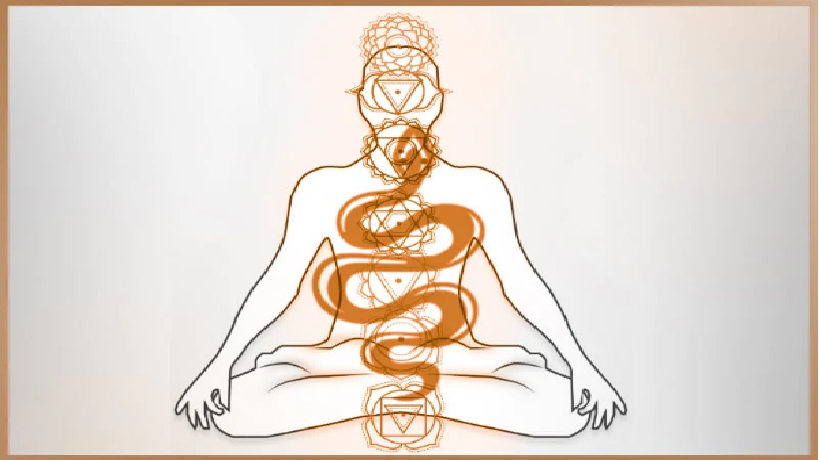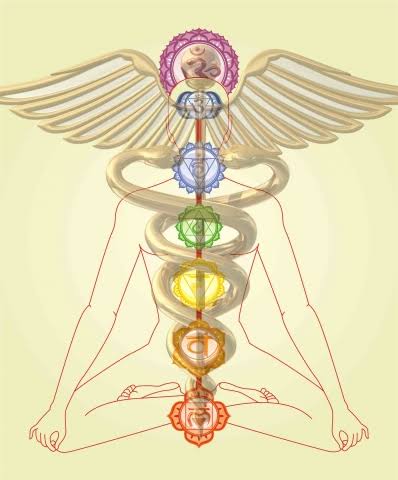Kundalini Yoga Training



Kundalini Yoga Training
Kundalini Yoga: (kuṇḍalinī-yoga) derived from kundalini, defined in tantra as energy that lies dormant within the body, frequently at the base of the spine. In normative tantric systems kundalini is considered to be dormant until it is activated (as by the practice of yoga) and channeled upward through the central channel ( Sushumna Nadi - Sushumna : Main Energy channel ie. The Spine from base of spine running all the way up to the top of the head - Nāḍī : is a term for the channels through which, in traditional Indian medicine and spiritual theory, the energies such as prana of the physical body, the subtle body and the causal body are said to flow. Within this philosophical framework, the nadis are said to connect at special points of intensity, the chakras.)
In a process of spiritual perfection. Other schools, such as Kashmir Shaivism, teach that there are multiple kundalini energies in different parts of the body which are active and do not require awakening. Kundalini is believed by adherents to be power associated with the divine feminine, Shakti.
Kundalini yoga as a school of yoga is influenced by Shaktism and Tantra schools of Hinduism. It derives its name through a focus on awakening kundalini energy through regular practice of mantra, tantra, yantra, yoga, laya, haṭha, meditation, or even spontaneously (sahaja).
In 1968, Harbhajan Singh Khalsa, also known as Yogi Bhajan, introduced kundalini yoga into the United States, "Kundalini Yoga as taught by Yogi Bhajan". Includes yogic postures and techniques, attached to Tantric theories and Sikh mantras, synthesizing a new form of 'Kundalini' yoga." not a distinct practice, but essentially a combination of yogic mechanics learned and passed on to the west along with Sikh-derived mantras (Ik Ongkaar, Sat Naam, Sri Waheguru)
The practice of kriyas and meditations in Kundalini Yoga are designed to raise body awareness to prepare the body, nervous system, and mind to handle the energy of Kundalini rising. The majority of the physical postures focus on navel activity, activity of the spine, and selective pressurization of body points and meridians. Breath work and the application of bandhas (3 yogic locks) aid to release, direct and control the flow of Kundalini energy from the lower centers to the higher energetic centers.
Along with the kriyas, meditations and practices of Kundalini Yoga, a simple breathing technique of alternate nostril breathing (left nostril, right nostril) is taught as a method to cleanse the nadis, or subtle channels and pathways, to help awaken Kundalini energy.
" Sovatsky (1998) adapts a developmental and evolutionary perspective in his interpretation of Kundalini Yoga. That is, he interprets Kundalini Yoga as a catalyst for psycho-spiritual growth and bodily maturation. According to this interpretation of yoga, the body bows itself into greater maturation' none of which should be considered mere stretching exercises"
Kundalini Yoga Practice:
Kundalini is the term for "the spiritual energy or life force located at the base of the spine", conceptualized as a coiled-up serpent. The practice of Kundalini yoga is supposed to arouse the sleeping Kundalini Shakti from its coiled base through the 6 chakras, and penetrate the 7th chakra, or crown. This energy is said to travel along the ida (left), pingala (right) and central, or sushumna nadi - the main channels of pranic energy in the body.
Kundalini energy is technically explained as being sparked during yogic breathing when prana and apana blends at the 3rd chakra (navel center) at which point it initially drops down to the 1st and 2nd chakras before traveling up to the spine to the higher centers of the brain to activate the golden cord - the connection between the pituitary and pineal glands - and penetrate the 7 chakras, Crown Chakra / Sahasrara Chakra.
Borrowing and integrating many different approaches, Kundalini Yoga can be understood as a tri-fold approach of Bhakti yoga for devotion, Shakti yoga for power, and Raja yoga for mental power and control. Its purpose through the daily practice of kriyas and meditation in sadhana - spiritual practice, are described as a practical technology of human consciousness for humans to achieve their total creative potential. With the practice of Kundalini Yoga one is thought able to liberate oneself from one's Karma and to realize one's Dharma (Life Purpose).
Kundalini yoga is a form of yoga that involves chanting, singing, breathing exercises, and repetitive poses.
Its purpose is to activate your Kundalini energy, or shakti. This is a spiritual energy that’s said to be located at the base of your spine.
As Kundalini yoga awakens this energy, it’s supposed to enhance your awareness and help you move past your ego. Sometimes, the practice is also called “yoga of awareness.”
So in short What is Kundalini yoga?
Although Kundalini yoga is practiced around the world, its origin is unknown. The concept of Kundalini energy has been around for centuries and was mentioned in ancient Vedic texts from 1,000 B.C.
Kundalini yoga is most associated with Yogi Bhajan, a yoga teacher from Pakistan. He’s credited with introducing the practice to Western countries in the 1960s.
The term “Kundalini” comes from the Sanskrit word “kundal,” which means “circular.” It also refers to a coiled snake. And according to practitioners, Kundalini energy is like that coiled snake: It sits at the base of your spine, sleeping and unaroused.
Kundalini yoga is practiced to activate this energy, which allows it to move up and through the chakras along your spine.
In yoga, chakras are the seven energy centers in your body. They include:
* root chakra
* sacral chakra
* naval, or solar plexus, chakra
* heart chakra
* throat chakra
* third eye chakra
* crown chakra
As Kundalini energy rises, it’s believed to help balance these chakras and contribute to your spiritual wellness.
With regular practice, Kundalini yoga is said to lead to spiritual enlightenment. This is called a “Kundalini awakening.” How does it differ from other types of yoga?
Compared with other forms of yoga, Kundalini yoga is a more spiritual practice.
It still involves physical movements, but they aren’t the primary focus. This is different from hatha or vinyasa yoga, for example, which both revolve around physical poses.
Kundalini yoga is also more precise and repetitive. Whereas other types of yoga flow with your breath, Kundalini yoga combines chanting, singing, movements, and breathing in specific patterns.
What is Kundalini Yoga all About: breathing, mantras, kriyas, and mudras
Kundalini yoga consists of eight main main components, but we will look at six for now which are done in the following order:
* Opening chant. Every class begins with an opening chant, also known as tuning in.
* Pranayama or warmup. You’ll do breathing exercises, called pranayama, and sometimes also movements to stretch your spine. The goal of pranayama is to practice breath control.
* Kriya. A kriya is a sequence of postures, pranayama, mudras (hand positions), sounds, and meditation. The length and intensity of the kriya depends on your instructor.
* Relaxation. This allows your body and mind to absorb the effects of a kriya.
* Meditation. Your instructor guides you through meditation to cultivate awareness.
* Closing chant. The class ends with a closing chant.
What are the benefits?
* Stress and anxiety relief.
* Improves cognitive function.
* Boosts self-perception.
* Spiritual enlightenment.
The purported benefits may include the following:
* more empathy
* increased creativity
* improved charisma
* increased energy
*internal peace
Beginners to Intermediate Level welcome, classes are held once or twice a week depending on availability / flexible hours for Kundalini Yoga Classes.
Kundalini Yoga Classes available in two options Basic or Introduction and Advanced.
Kundalini Yoga Introduction Class:
Class R3500 (2 hour)
Advanced Kundalini Yoga Class:
Classes R4500 (8 hour)
Call or whatsapp me to book your slot. 0764559916
